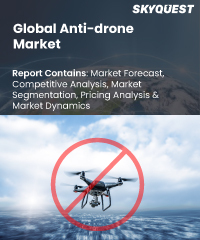
Product ID: SQMIG20A2190

Report ID:
SQMIG20A2190 |
Region:
Global |
Published Date: April, 2024
Pages:
202
|
Tables:
195 |
Figures:
80
Global Anti-drone Market size was valued at USD 1.44 Billion in 2022 and is poised to grow from USD 1.84 Billion in 2023 to USD 13.38 Billion by 2031, at a CAGR of 28.1% during the forecast period (2024-2031).
The prevalence of public safety infractions has grown dramatically as a result. The tracking and record keeping of these drones has played a significant role in security management initiatives, hastening the expansion of the anti-drone market. There will likely be more government safety worries as unmanned aerial vehicles gain in popularity. Accordingly, during the course of the forecast period, this is anticipated to support the expansion of the anti-drone market.
The increasing prevalence of these unauthorized flying test devices has increased the risk to global safety. These aircraft systems have several sensors that can record audio and video at any time and in any location. By developing new UAV lowering technology to combat them, manufacturers are putting more effort into reducing the usage of drones in aviation. Leading international governmental organizations, including the Federal Aviation Administration (FAA) in the U.S., encourage the promotion and advancement of cutting-edge drone mapping and acquisition technology because it provides precise tracking, advanced detection, anti-chase, and path finding (DF) capabilities.
To maintain up with the growing demand for anti-drone systems, producers have greatly improved their production capacity, which is propelling market expansion. As part of their air defense, governments frequently employ missiles and ready air force fighters. However, it seems that small drones & UAVs pose a greater threat than fighter jets & missiles do. Governments and businesses all around the world are investing more in the creation and promotion of anti-UAV technologies to combat such dangers. To increase the overall effectiveness of their anti-UAV systems, manufacturers are integrating various drone detecting methods.
Additionally, various systems rely on various strategies for flying system detection. The detection of drones using radio frequency (RF), electro optical (EO), infrared radiation (IR), & radar-based (RB) approaches is a novel methodology. The communication among the drones & their base node is obstructed by RF jamming, which distorts the messages. Therefore, it is anticipated that increased demand for RF jammer devices to prevent drone movements in prohibited airspaces would contribute to the expansion of the anti-drone industry.
The outbreak and spread of COVID-19 have also had a negative impact on the market's rate of expansion. The growth rate of the anti-drone market is being impacted by the inputs from numerous businesses that fall under various segments of the value chains, including OEM, consumers, and distributors. Additionally, the COVID-19 epidemic had an impact on the commercial market's perception of the demand for anti-UAV equipment from the Middle East, Africa, and regions of Europe. However, because of international political concerns like the continuing Russia-Ukraine war, demand for drone technology and systems is anticipated to rise after COVID-19.
US Anti-drone Market is poised to grow at a sustainable CAGR for the next forecast year.
Our industry expert will work with you to provide you with customized data in a short amount of time.
REQUEST FREE CUSTOMIZATIONWant to customize this report? This report can be personalized according to your needs. Our analysts and industry experts will work directly with you to understand your requirements and provide you with customized data in a short amount of time. We offer $1000 worth of FREE customization at the time of purchase.

Product ID: SQMIG20A2190